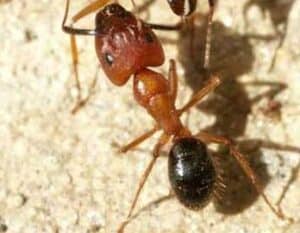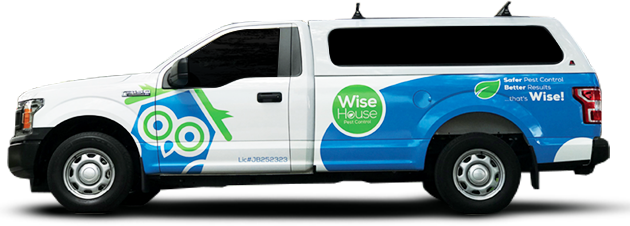
Florida carpenter ants, primarily identified as Camponotus floridanus and Camponotus tortuganus, are two of the most common carpenter ant species found in the state. These ants are among the largest ants in the United States, with workers ranging from 1/4 to 1/2 inch in length.
Characterized by their black or dark reddish-black coloration, these ants are known not for consuming wood but for their habit of excavating inside wood to create their nests. This behavior allows them to form smooth, hollow galleries within wooden structures, where they establish their colonies. Unlike many other ant species that might be more generalized in their nesting habits, Florida carpenter ants specifically prefer moist, decaying wood, often making older buildings and poorly maintained structures their prime targets.
Their presence is often indicated not by sawdust, as one might expect with termites, but by the appearance of large, winged ants during their mating season, and occasionally, by faint rustling sounds within the walls as they go about their activities.
Carpenter ants pose a significant problem in South Florida due to their destructive nesting habits, which can compromise the structural integrity of infested buildings. The warm, humid climate of the region provides an ideal environment for these ants to thrive and multiply. Once they establish a nest within a structure, they can continue to expand into other wooden elements, causing more extensive damage over time.
This is particularly concerning in areas like South Florida, where high humidity can also lead to other forms of wood decay, compounding the damage caused by the ants. Moreover, because carpenter ants like moisture, moisture-related issues in a building, such as leaks or condensation problems, can lead to additional expenses in repairs beyond just the repair of ant damage.
Their ability to remain hidden within structures for long periods allows them to build large colonies that are difficult to eradicate once established, often requiring professional pest control services to fully address the infestation. This makes carpenter ants a formidable pest in residential homes and commercial buildings.
Identifying a carpenter ant infestation involves looking for specific signs and behaviors associated with these pests. Because carpenter ants are not always visible, understanding the subtle clues they leave behind is important for early detection and effective management. Here’s how you can identify a carpenter ant infestation in your home or property:
Physical Sightings of Ants
One of the most straightforward ways to identify an infestation is by spotting the ants themselves. Carpenter ants are larger than most other ant species, typically ranging from 1/4 to 1/2 inch in length. They can appear in a variety of colors but are most commonly black or dark reddish-black. Seeing large, winged ants, known as swarmers, inside your home can be a clear indicator of an indoor colony, especially if observed during spring or early summer, which is their typical swarming period.
Frass and Wood Shavings
Carpenter ants excavate wood to create their nests, which results in the production of wood shavings or frass. This material, which resembles sawdust, is often found beneath wooden items or entry points into their nests. Unlike termites, carpenter ants do not consume the wood, so the frass is clean and free of feces. Finding piles of frass can indicate active nesting within wooden structures.
Sounds Within Walls
Carpenter ants are active mostly at night. During quiet times, you might hear a faint rustling or crunching noise coming from inside walls, floors, or ceilings. These sounds are produced by the ants as they chew through wood to expand their nests or when they’re moving around within their galleries.
Damaged Wood
Inspect wood structures for smooth, clean galleries that are free from mud or debris, which is typical of carpenter ant activity. Wood damaged by carpenter ants will have these clean, hollowed-out sections, often along the grain. The galleries tend to be more irregular than those made by termites, reflecting the ants’ random excavation patterns as they search for suitable nesting spots.
Trailing Behavior
Carpenter ants typically forage at night. You might observe a trail of ants moving to and from their nest, particularly if there is a food source in the vicinity. These trails can lead you back to their nest entry points, which are often located around windows, door frames, or other moist, decay-prone areas of a structure.
Identifying a carpenter ant infestation early is crucial to preventing significant damage. Regular inspections for these signs, especially in older buildings or those in moist environments, can help catch an infestation before it becomes severe. If you suspect that carpenter ants are establishing a colony within your property, you should contact a pest control company such as Wise House Environmental Services to assess the situation and recommend an appropriate course of action.
Carpenter ants are versatile in their nesting preferences but typically choose environments that provide moisture and protection. Identifying common nest sites in and around your property can help you detect an infestation early and take preventive measures to control the spread. Here’s a look at some common nesting sites for carpenter ants, particularly in South Florida:
Indoor Nesting Sites
Outdoor Nesting Sites
By understanding and monitoring common nest sites, you can take proactive steps to prevent carpenter ants from becoming a persistent problem.
Dealing with a carpenter ant infestation can sometimes be managed with DIY methods, but there are certain situations where calling a professional pest control specialist may be a better option. Here’s when you should consider professional help:
Extensive Infestation
If you observe large numbers of carpenter ants, particularly in different areas of your home, this could indicate an extensive infestation. Carpenter ants can establish multiple nests, both primary (containing the queen, eggs, and young) and satellite (primarily workers and mature larvae). Multiple nests can complicate eradication efforts because treating just one nest may not eliminate the problem.
Presence of Swarmers Inside Your Home
Finding winged ants, known as swarmers, inside your home usually signifies that the colony is well-established and looking to expand. These winged carpenter ants are reproductive members that leave the nest to mate and start new colonies. Their presence indoors often suggests that the parent colony feels sufficiently secure and large enough to invest resources in reproduction, a sign of a significant infestation.
Recurring Ant Problems
If you’ve attempted to control a carpenter ant problem on your own but find that the ants keep returning, it could be a sign that home remedies or over-the-counter solutions are not effectively reaching the heart of the colony or colonies. Professional pest control specialists have the expertise and knowledge to administer more comprehensive treatments that can more effectively eliminate carpenter ants.
Inaccessible Nest Locations
Carpenter ants often build nests in locations that are difficult to reach, such as behind walls, in attics, or under foundations. If you suspect that the nest is in an inaccessible area, a professional can deploy specialized equipment and techniques, such as injecting insecticides directly into nesting sites through drilled holes, which are not typically feasible for DIY methods.
To Prevent Structural Damage
Because carpenter ants burrow into wood to create their nests, they can cause structural damage over time. If you notice signs of weakened wood structures, sagging floors, or hollow-sounding beams, it’s important to call a pest control professional immediately to prevent further damage. A professional can assess the extent of the infestation and the associated damage, offering solutions to both eradicate the ants and suggest repairs or preventive measures.
Carpenter ants are most active in South Florida during the warmer months, typically starting in late spring through to early fall. During this time, they are most visible as they forage for food and expand their colonies.
A carpenter ant colony can continue to grow and thrive for many years if not addressed. A mature colony can contain thousands of ants, including one or more reproductive queens, workers, and developing larvae.
Yes, carpenter ants can bite if they feel threatened. However, their bites are not venomous and generally do not cause significant harm, though they might be painful and could lead to skin irritation.
Yes, while carpenter ants typically prefer dead or decaying wood, they can also infest and potentially weaken living trees, especially those that are already stressed or diseased.
Carpenter ants are attracted to moist environments. Leaky pipes, poorly ventilated areas, and any wooden structures in contact with water or soil are particularly susceptible. They are also attracted to sweet foods and proteins, which can bring them into your home.
Locating a carpenter ant nest requires looking for signs of frass (wood shavings), following trails of worker ants back to their nest, and listening for the rustling noises they make in wood. This can be challenging, and hidden nests often require professional tools for detection.
If your neighbor has carpenter ants, it’s a good idea to conduct a thorough inspection of your own home and property to check for signs of an infestation. Carpenter ants can travel significant distances, and nearby colonies can spread to your property.
While it’s not always feasible to remove every single ant, the goal is to eliminate the queen and the main colony to prevent further reproduction and damage. Management efforts should focus on substantial reduction and control to minimize the impact on your property.

Ready to send away pests without harming your pets? Getting started with Wise House Environmental Services is as easy as 1-2-3:
With Wise House Environmental Services, you get more than just effective pest control; you get peace of mind, knowing that your home is without pests and safer for your pets.
Our approach to pest control combines science with safety, offering you the kind of targeted, effective solutions that you won’t find with just any other pest control service. Our services have made a world of difference for homeowners, and we can do the same for you. Your pets will thank you for it!
We serve Port St. Lucie,Lake Worth, Boyton Beach, Palm Beachand the Treasure Coast.


© 2023 All Rights Reserved. | Sitemap